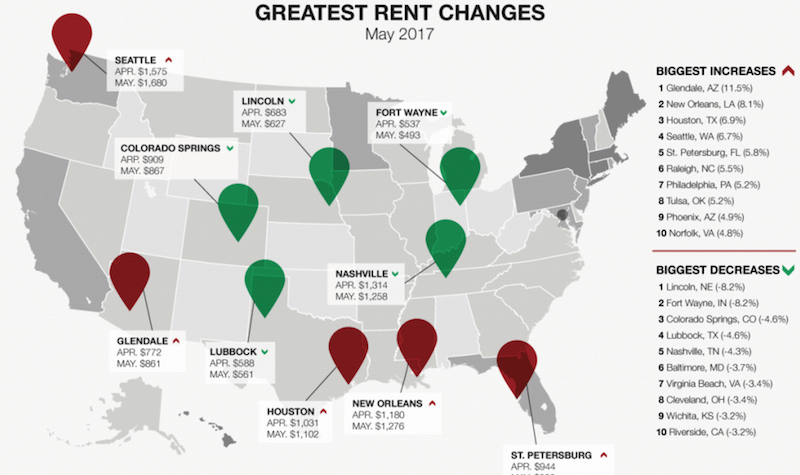Nationally, rent prices increased slightly in April, with the median one-bedroom rent rising to $1,012 per month. That’s the highest it’s been since January’s figure of $1,016, and represents an overall decline since the beginning of the year of .39%.
When it came to the steepest rent drops, two familiar faces led the way: Lincoln, Neb., and Fort Wayne, Ind. Each city’s rent dropped 8.2%, to continue a months-long slide. Lincoln’s median rent of $627 represents a 21% decrease from its January rent of $801, and Fort Wayne’s $493 is a 26.4% decline from its year-opening rent of $671 per month.
Those declines might seem steep. One explanation: In order to better approximate what an apartment-seeker would experience when looking for a place to rent, ABODO collects data only on active listings currently on the market, which can vary widely month-to-month, depending on supply.
The rest of the biggest decreases were more minor, between 3% and 5%. A number of cities — Lubbock, Texas (-4.6%); Nashville, Tenn. (-4.3%); Cleveland, Ohio (-3.4%); and Riverside, Calif. (-3.2%) — reprised their places on the list of greatest decreases for the second month in a row. In fact, this marks the third straight month that Nashville, Cleveland, and Riverside appeared on the list of greatest rental falls.
The nation’s largest rental hike came in Glendale, AZ, where one-bedroom median rents rose 11.5% to $861. That marks the continuation of a months-long trend: Glendale rents have increased every month since January, and currently they’re 26% higher than they were at the beginning of the year. New Orleans (8.1%), Seattle (6.7%), and Phoenix (4.9%) also reprise their places on the list of biggest rent increases.
The list of cities with the nation’s highest rents in April is largely unchanged from our last report. San Francisco’s $3,415 price tag still leads the way, followed by New York City, N.Y. ($2,705), San Jose, Calif. ($2,459); and Boston, Mass. ($2,398). The only newcomer is Seattle, whose 6.7% rental jump to $1,680 puts it at the tenth-highest in the country.
For the full report and to view associated infographics and charts, click here.
Related Stories
| Nov 7, 2014
Prefab helps Valparaiso student residence project meet an ambitious deadline
Few colleges or universities have embraced prefabrication more wholeheartedly than Valparaiso (Ind.) University. The Lutheran-based institution completed a $27 million residence hall this past summer in which the structural elements were all precast.
| Nov 3, 2014
Novel 'self-climbing' elevator operates during construction of high-rise buildings
The JumpLift system from KONE uses a mobile machine room that moves upward as the construction progresses, speeding construction of tall towers.
| Nov 3, 2014
Cairo's ultra-green mixed-use development will be topped with flowing solar canopy
The solar canopy will shade green rooftop terraces and sky villas atop the nine-story structure.
| Oct 31, 2014
Dubai plans world’s next tallest towers
Emaar Properties has unveiled plans for a new project containing two towers that will top the charts in height, making them the world’s tallest towers once completed.
| Oct 29, 2014
Better guidance for appraising green buildings is steadily emerging
The Appraisal Foundation is striving to improve appraisers’ understanding of green valuation.
| Oct 27, 2014
Studio Gang Architects designs residential tower with exoskeleton-like exterior for Miami
Jeanne Gang's design reinvents the Florida room with shaded, asymmetrical balconies.
| Oct 21, 2014
Passive House concept gains momentum in apartment design
Passive House, an ultra-efficient building standard that originated in Germany, has been used for single-family homes since its inception in 1990. Only recently has the concept made its way into the U.S. commercial buildings market.
| Oct 21, 2014
Perkins Eastman white paper explores state of the senior living industry in the Carolinas
Among the experts interviewed for the white paper, there was a general consensus that the model for continuing-care retirement communities is changing, driven by both the changing consumers and more prevalent global interest on the effects of aging.
| Oct 16, 2014
Perkins+Will white paper examines alternatives to flame retardant building materials
The white paper includes a list of 193 flame retardants, including 29 discovered in building and household products, 50 found in the indoor environment, and 33 in human blood, milk, and tissues.
| Oct 15, 2014
Harvard launches ‘design-centric’ center for green buildings and cities
The impetus behind Harvard's Center for Green Buildings and Cities is what the design school’s dean, Mohsen Mostafavi, describes as a “rapidly urbanizing global economy,” in which cities are building new structures “on a massive scale.”
















